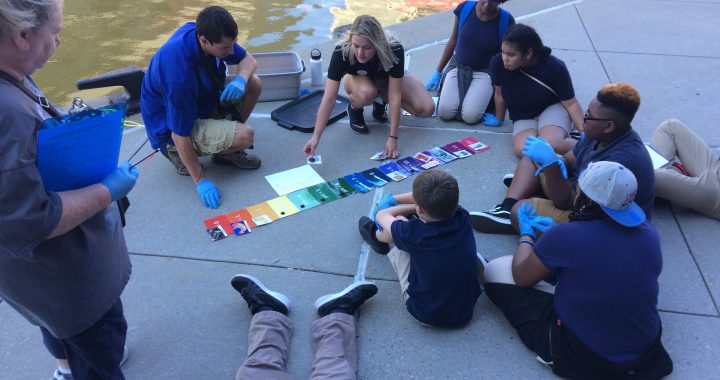By Sarah Haines and Joe Harber
Changes to K-12 Maryland state education standards have created an increased need to support school districts in providing meaningful environmental experiences for all students. Concomitantly, there is a critical need to prepare preservice K-12 teachers during their undergraduate academic programs to meet the Maryland State Department of Education’s environmental education standards upon entry into the profession. The purpose of our project was to address these needs by forming a partnership between a postsecondary institution (i.e., Towson University) and an informal science education center (i.e., National Aquarium). This partnership allowed Towson University students (i.e., preservice teachers) to serve as National Aquarium educational instructors who delivered environmental activities onsite at the Aquarium to students in local urban schools. Our hope is that the preservice teachers have increased their STEM content knowledge and developed their pedagogical skills for teaching environmental science. The preservice teacher interns assisted the National Aquarium’s education specialists in expanding the Aquarium’s urban education programs by working with students and teachers from Baltimore City and the surrounding counties. The preservice teachers also had the opportunity to engage the public in the aquarium on topics related to conservation and environmental stewardship.
The main activities associated with our project took place from August through November 2017. In August 2017, we had our first class meeting on campus at Towson University. We introduced students to the project and the associated coursework. Students also completed the pre-survey for the Students Assessment of Learning Gains (SALG) as well as another pre-survey we will use to evaluate the project, the STEBI (Science Teacher Efficacy Belief Instrument). In September, we began meeting weekly at the National Aquarium. Students received training from the educational staff on all the programming they would be delivering. We also set aside time for students to practice in a microteaching format before they began teaching school-age children who would be participating in field trips at the aquarium.
Four weeks of class time were spent delivering programming on water quality assessment outside on the two piers surrounding the aquarium to Baltimore City Schools middle school students participating in the “What Lives in the Harbor?” program. This program is a pilot project funded by the National Oceanic and Atmospheric Administration. Programs began each day at 10:00 a.m. and ended at approximately 1:15 p.m. Towson University preservice teachers taught in pairs, and each pair presented one of six stations (content was grouped into twos): Plankton and turbidity, dissolved oxygen and salinity, and temperature and pH. After the schoolchildren rotated through these stations, the Towson University preservice teachers facilitated an exploration of a set of oyster cages that were placed on the water along the harbor’s edge.
After these programs ended in late October, the Towson University students received a refresher on School Programs from aquarium staff. School Programs are hands-on science activities offered to school groups visiting the Aquarium. Approximately 5,000 students participate in School Programs annually. The Towson University students delivered these School Programs: Biomes, Adaptations, and Squid Dissection/Lab. In addition, the Towson students also engaged with the public using live aquatic invertebrates at the Living Seashore exhibit, a special touch tank that allows visitors to touch and come close to a variety of aquatic life including, horseshoe crabs, stingrays and jellies. In between teaching times, the Towson University students also surveyed Aquarium guests about the visitor experience.
As far as our outcomes are concerned, knowledge outcomes were measured through traditional course exams/quizzes and through the writing and delivery of lesson plans. These data show that students did make learning gains in content knowledge and pedagogy as the semester progressed. Average scores on the two quizzes (based on content) were 92% and 99%. Student scores on their written lesson plans improved over the course of the semester as well. The first lesson plan assignment had class average of 87%, while the last lesson plan assignment had an average score of 98%.
Attitude outcomes were measured through pre/post data taken from the STEBI (Science Teacher Efficacy Belief Instrument), which was be administered to all Towson University students enrolled in the course. Paired t-test results show that the experiences at the aquarium led to an increase in both science teaching self-efficacy (p=.001) and teaching outcome expectancy (p=.04).
Interest outcomes were measured through the STEBI and through weekly reflections assigned to the students as part of their course grades. These data show that overall, students became more interested in science and watershed issues in particular because of participating in this course.
We consider our project to be a success because of the following:
- University students met the goals we had for the project, and had mostly positive things to say about their experience.
- University students and faculty worked effectively with aquarium staff to deliver quality watershed education programs to Baltimore City Public School students.
We are excited to announce that our partnership will be continuing for the 2018-2019 academic year. Towson preservice teachers will once again return to the aquarium to teach K-12 students visiting the aquarium on field trips. A graduate student will conduct research on the pre-service teachers at the aquarium as part of her Master’s thesis. She is hoping to publish and present the results with Dr. Haines in 2019.
This work was part of a project funded by a sub-award provided by SENCER-ISE through the project, Partnership Champions: SENCER ISE and Professional Development Through Mentoring to Enhance Learning Environments (MG-10-15-0071-15A). Partnership Champions is funded by the Institute of Museum and Library Services.
Photograph by Joe Harber

